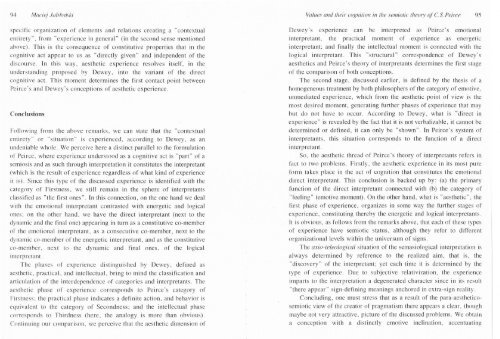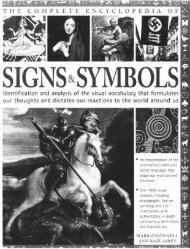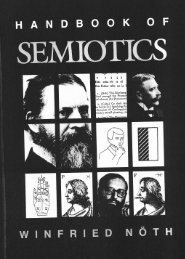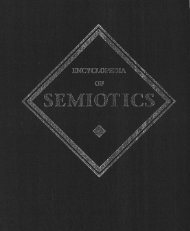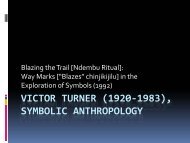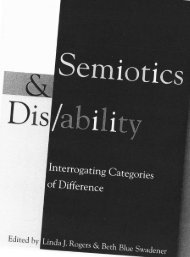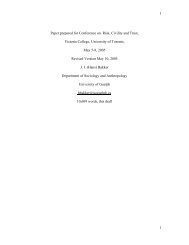Musical Semiotics in Growth - SemioticSigns.com
Musical Semiotics in Growth - SemioticSigns.com
Musical Semiotics in Growth - SemioticSigns.com
Create successful ePaper yourself
Turn your PDF publications into a flip-book with our unique Google optimized e-Paper software.
94 Macie.j .ltrltfttri.ski<br />
specil'ic organizalion of elements and relatiorrs creat<strong>in</strong>g a "contextual<br />
entircty". I'rom "experience <strong>in</strong> gencral" (<strong>in</strong> the second sense mentioned<br />
ahove). This is the consequence of constitutive properties that <strong>in</strong> the<br />
cognitive act appear to us as "directly given" and <strong>in</strong>dependent of the<br />
discourse. In this way, aesthetic expericnce resolves itself, <strong>in</strong> the<br />
understand<strong>in</strong>g proposed hy Dewey, <strong>in</strong>to the variant of the dtrect<br />
cognitive act. '['his monrent determ<strong>in</strong>es the first contact po<strong>in</strong>t between<br />
Peirce's ancl Dcwey's conccptions of aesthetic experience.<br />
Conclusions<br />
Follow<strong>in</strong>g fronr the above renrarks. we can state that the "contextual<br />
entirety" or "situation" is experienccd. accord<strong>in</strong>g to Dewey. as an<br />
undeniable rvhole. We perceive here a dist<strong>in</strong>ct parallel to the fbrmulation<br />
o1'Peircc. wlrere cxperience understood as a cognitive act is "part" of a<br />
senriosis and as such through <strong>in</strong>terpretation it constitutes the <strong>in</strong>terpretant<br />
(which is the result of experience regardless of what k<strong>in</strong>d of experience<br />
it is). S<strong>in</strong>ce thrs type of the discussed experience is identified with the<br />
category of lrirstness. we still rcnta<strong>in</strong> <strong>in</strong> the sphere of <strong>in</strong>terpretants<br />
classified as "thc flrst ones". In this connection. on the one hand we deal<br />
with the emotional <strong>in</strong>terpretant contrasted with energetic and logrcal<br />
ones: on the other hand, rve havc the direct <strong>in</strong>terpretant (next to the<br />
dynamic and the f<strong>in</strong>al one) appear<strong>in</strong>g <strong>in</strong> turn as a constitutive co-rnember<br />
of thc cmotional <strong>in</strong>terpretant, as a consecutive co-menrber, next to the<br />
dynanric co-mernber of thc energetic <strong>in</strong>terprctant, and as the constitutive<br />
co-rnembcr. ncxt to thc dynarlic and f<strong>in</strong>al ones, of thc logical<br />
lnterprctant.<br />
Thc phascs of cxpericnce dist<strong>in</strong>guished hy Dewey, def<strong>in</strong>ed as<br />
aesthctic, practic:al. and <strong>in</strong>tellectual, br<strong>in</strong>g to nr<strong>in</strong>d the classification ancl<br />
articulation of the <strong>in</strong>terdcpendence of categorics and <strong>in</strong>terpretants. The<br />
aesthctic phasc of experiencc corresponds to Peirce's category of<br />
Firstncss; the practical phase <strong>in</strong>dicatcs a def<strong>in</strong>ite action, and behavior is<br />
equivalcnt to the category of Secondness; and the <strong>in</strong>tellectual phase<br />
corrcsponds to -fhirdness (here. the analogy is nrore than obvious).<br />
Cont<strong>in</strong>u<strong>in</strong>g our conrparisou, we perceive that the aesthetic dimension of<br />
Vttlues and lheir cognition <strong>in</strong> the semiotir: theory of C.S.Peirce 9-5<br />
Dewey's experience can he <strong>in</strong>terpreted as Peirce's emotional<br />
<strong>in</strong>lcrprctant. the practical monrent of cxpcrience as crrcrgctic<br />
<strong>in</strong>terprctant; and f<strong>in</strong>ally the <strong>in</strong>tellectual rnoment is connectcd with the<br />
logical <strong>in</strong>terpretant. This "structural" correspondence of Dewey's<br />
aesthetics and Peirce's theory of <strong>in</strong>terpretants detenn<strong>in</strong>es tlre first stage<br />
of the conrparison of both conceptions.<br />
The second stage, discussed earlier, is dcfrned by the thesis of a<br />
homogeneous treatrnent by both philosophers of the category of emotive,<br />
unmediated experience, which from the aesthetic po<strong>in</strong>t of view is the<br />
rnost desired monrent, generat<strong>in</strong>g further phases of experience that rnay<br />
but do not have lo occur. Accord<strong>in</strong>g to Dewey, what is "direct <strong>in</strong><br />
cxperience" is revealed hy the fact that it is not vcrbalizable, it cannot be<br />
determ<strong>in</strong>ed or def<strong>in</strong>ed, it can only he "shown". In Peirce's systern of<br />
<strong>in</strong>terpretants, this situation corresponds to the function of a direct<br />
<strong>in</strong>terpretant.<br />
So. the aesthctic thread of Peirce's theory of <strong>in</strong>terprctants relcrs <strong>in</strong><br />
{'act to two prohlcrns. Firstly, the aesthetic cxpcrience irt its rnost pure<br />
lbrnr takes place <strong>in</strong> the act of cognition that constitutes the emotional<br />
clirect <strong>in</strong>terpretant. This conclusion is backed up by: (a) the primary<br />
function of the direct <strong>in</strong>terpretant connected with (b) the category of<br />
"feel<strong>in</strong>g" (emotive moment). On the other hand, what is "aesthetic", the<br />
first phase of experience. rrrganizes <strong>in</strong> some way the further stages of<br />
experience, constitut<strong>in</strong>g thereby the energetic and logical <strong>in</strong>terpretants.<br />
It is obvious, as follows from the remarks above, tlrat each of'these types<br />
of experience have seniotic status, although they refcr to diff'erent<br />
organizationalevels with<strong>in</strong> the universum of signs.<br />
The a-xio-teleological situation of the semasiological <strong>in</strong>terpretation is<br />
always determ<strong>in</strong>ed by reference to the realized aim, that is, the<br />
"discovery" of the <strong>in</strong>terpretant; yet each time it is determ<strong>in</strong>ed by the<br />
type o1' cxperience. Due 1o subiective relativization, the experir'ncc<br />
imparts to the <strong>in</strong>terpretation a degenerated character s<strong>in</strong>ce <strong>in</strong> its rcsult<br />
"there appear" sign-def<strong>in</strong><strong>in</strong>g rnean<strong>in</strong>gs ancht'rrecl <strong>in</strong> extra-sign reality.<br />
Conclud<strong>in</strong>g, onc must stress that as a result of the para aestheticoscmiotic<br />
view clf the creator of pragnratism there appears a clear, though<br />
maybe not very attractive. picture of the discussecl problents. We obta<strong>in</strong><br />
a conception witlr a dist<strong>in</strong>ctly enrotive <strong>in</strong>cl<strong>in</strong>ation, accentuat<strong>in</strong>g


